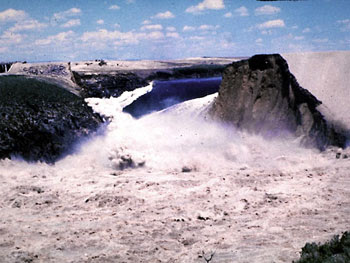Water pouring out of the reservoir of the Teton Dam in Idaho following its catastrophic failure on June 5, 1976.
June 5, 1976:
The Teton Dam was a federally built earthen dam in the United States. On the Teton River in eastern Idaho, it was between Fremont and Madison counties. As it filled for the first time, it suffered a catastrophic failure on June 5, 1976. The collapse of the dam resulted in the deaths of 11 people and 13,000 head of cattle. The dam cost about $100 million to build, and the federal government paid over $300 million in claims related to the dam failure. Total damage estimates have ranged up to $2 billion. The dam has not been rebuilt.Catastrophic failure is every engineer's worst nightmare.
The dam site is located in the eastern Snake River Plain, which is a broad tectonic depression on top of rhyolitic ash-flow tuff. The tuff, a late-Cenozoic volcanic rock dates to about 1.9 million years and sits on top of sedimentary rock. The area is very permeable, highly fissured and unstable. Test boreholes, drilled by engineers and geologists employed by the Bureau of Reclamation showed that one side of the canyon was highly fissured, a condition unlikely to be remediated by the Bureau's favored method of "grouting" (injecting concrete into the substrates under high pressure).
The primary contractor was Morrison-Knudsen Co. of Boise, assisted by Peter Kiewet Sons Co. of Omaha, Nebraska. The $39 million contract was awarded in December 1971 and work began in 1972. Authorized by Congress in 1964, the dam was completed in November 1975 and no seepage was noted on the dam itself before the date of the collapse. However, on June 3, 1976, workers found two small springs had opened up downstream.
At the time of the collapse, spring runoff had almost filled the new reservoir to capacity, with a maximum depth of 240 feet (73 m). Water began seeping from the dam on the Thursday before the collapse, an event not unexpected for an earthen dam. The only structure that had been initially prepared for releasing water was the emergency outlet works, which could carry just 850 cubic feet per second (24 m3/s). Although the reservoir was still rising over 4 feet (1.2 m) per day, the main outlet works and spillway gates were not yet in service. The spillway gates were cordoned off by steel walls while they were being painted.
On Saturday, June 5, 1976, at 7:30 a.m. MDT, a muddy leak appeared, suggesting sediment was in the water, but engineers did not believe there was a problem. By 9:30 a.m. the downstream face of the dam had developed a wet spot erupting water at 20 to 30 cubic feet per second (0.57 to 0.85 m3/s) and embankment material began to wash out. Crews with bulldozers were sent to plug the leak, but were unsuccessful. Local media appeared at the site, and at 11:15 officials told the county sheriff's office to evacuate downstream residents. Work crews were forced to flee on foot as the widening gap, now over the size of a swimming pool, swallowed their equipment. The operators of two bulldozers caught in the eroding embankment were pulled to safety with ropes.
At 11:55 a.m. MDT (UTC-17:55), the crest of the dam sagged and collapsed into the reservoir; two minutes later the remainder of the right-bank third of the main dam wall disintegrated. Over 2,000,000 cubic feet per second (57,000 m3/s) of sediment filled water emptied through the breach into the remaining 6 miles (9.7 km) of the Teton River canyon, after which the flood spread out and shallowed on the Snake River Plain. By 8:00 p.m. that evening, the reservoir had completely emptied, although over two-thirds of the dam wall remained standing.Study of the dam's environment and structure placed blame on the collapse on the permeable loess soil used in the core and on fissured (cracked) rhyolite in the foundations of the dam that allowed water to seep under the dam. The permeable loess was found to be cracked. It is postulated that the combination of these flaws allowed water to seep through the dam and led to internal erosion, called piping, that eventually caused the dam's collapse.

No comments:
Post a Comment